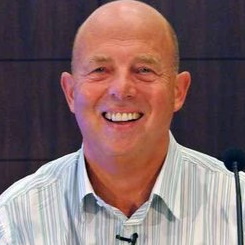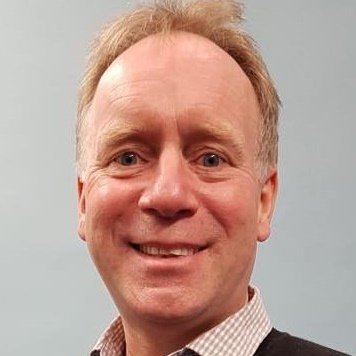REIMAGINE NEWSLETTER: ISSUE 37
EFFECTIVENESS AND APPLICABILITY OF VIRTUAL REALITY IN HEALTHCARE EDUCATION

Tom Gorman
Tom Gorman is an academic and theatre director currently based at Coventry University. Tom studied English Literature and Language at Queen’s University Belfast before going on to complete a PhD in Theatre at the University of Ulster researching the history of non-naturalistic dramaturgy especially the concept of the ‘play within a play’. From 1997 onwards he worked as Strand Leader in Drama at the University Of Birmingham, moving on to become Course Director of the BA Drama Studies degree at Bath Spa University. From 2007 onwards he has been working as Senior Lecturer on the BA Theatre and Professional Practice Degree at Coventry University.
He is currently engaged in a research project in conjunction with the University of Tampere, Finland, using videoconferencing technology, projections and sound design to create immersive rehearsal spaces using repurposed videoconferencing technology, life sized rear projections and theatrical spatial designs.
What do you believe to be the biggest challenge faced by educators currently?
The biggest challenge we face as arts educators is marrying technological innovation with human contact. The performing arts have always lagged behind other, more ‘traditional’ subjects when it has come to embracing online learning and telepresence technologies. The communal ethos behind most arts projects means that current online educational technologies struggle with the dynamics of the rehearsal and creative process.
What is the most interesting – or effective, or unique – approach or solution to education you’ve encountered recently?
There has been some really interesting work using telepresence technologies in the performing arts for instrumental tuition and musical collaboration. The Royal Danish academy of Music has introduced a Global Audition Training project “to educate student musicians about the cultural and historical nuances of the audition and performance experience around the world.” These technologies can enable significant international collaborations in the performing arts without the need for ever-increasing climate-destroying and expensive travel. They propose an innovative but easily implementable solution for long-distance collaboration that is mindful of the role of space and human interaction in fostering learning. Although reliant on technology applied innovatively, the strength of these systems should lie in making technologies a non-intrusive tool for increased meaningful personal contact between students and lecturers, performers and practitioners.

Bob Harrison
Bob Harrison has had extensive experience in schools and colleges as a teacher, lecturer senior manager, Principal and Governor. He has worked with Head teachers and senior leaders in developing leadership skills for the National College of Teaching and Leadership, advised DfES on the FE Principals Qualification and was the lead on Digital Futures for the Building Schools for the Future Leadership programme. Bob is also Chair of Governors at Northern College and Vice Chair of Governors a Trafford school. He is a Board member of the UfI Trust, a Judge for the BETT Awards, TES FE Awards and E Assessment awards.
What do you believe to be the biggest challenge faced by educators currently?
“The biggest challenges faced by educators when using technology to improve teaching, learning and assessment is how they can best creatively manage the tension between the Pedagogy and the technology. This requires visionary leadership, robust and reliable digital infrastructure, a digitally capable and confident workforce, a regulatory and accountability framework which supports innovation and a learner engagement strategy which supports the use of learner devices inside and outside the classroom“

Tim Stirrup
Tim trained as a teacher of mathematics and taught in London, England. He has worked in the private sector turning over more than £1m of sales in one month at the start of the 20th Century. He has worked for the UK Government and for startups at the very beginning of their journey. Tim now works as an edtech investor, with a brief to discover early stage edtech companies that could achieve success before they have even attracted seed funding. In the early/mid 2000’s Tim wrote an article about the adoption of ‘Learning platforms’. With little replacement, the advice he gave then still holds true today. Tim has been involved with the success of many multiple award-winning companies and over 30 years has seen every fad AND every useful application of technology for education. An edtech enthusiast, he is also an edtech sceptic.
What do you believe to be the biggest challenge faced by educators currently?
England’s recent edtech strategy detailed 5 areas in which technology could have a positive impact. In my opinion, 4 of these are inextricably linked. If tech can make ASSESSMENT more effective and efficient, then this can reduce ADMINISTRATIVE WORKLOAD, which in turn could allow time for new TEACHING PRACTICES. But underpinning all those is the PROFESSIONAL DEVELOPMENT teachers need to learn, introduce and integrate these technologies. The challenge is making the change required to do all four of these, and ensuring that development and time to change is given to teachers.
What is the most interesting – or effective, or unique – approach or solution to education you’ve encountered recently?
The use of calculators is a well-known issue in maths education. On the one hand they can speed things up. On the other, they can replace thinking and understanding. Ilan Samson in San Diego thought about the problem differently and created the QAMA calculator that asks users to estimate first before they get the precise answer. It is a calculator for understanding. As Ilan says “one cannot estimate by rote. You have to understand”. Freakonomics said that it could “end the math wars” and I use it all the time now on my phone, even for fun!”

